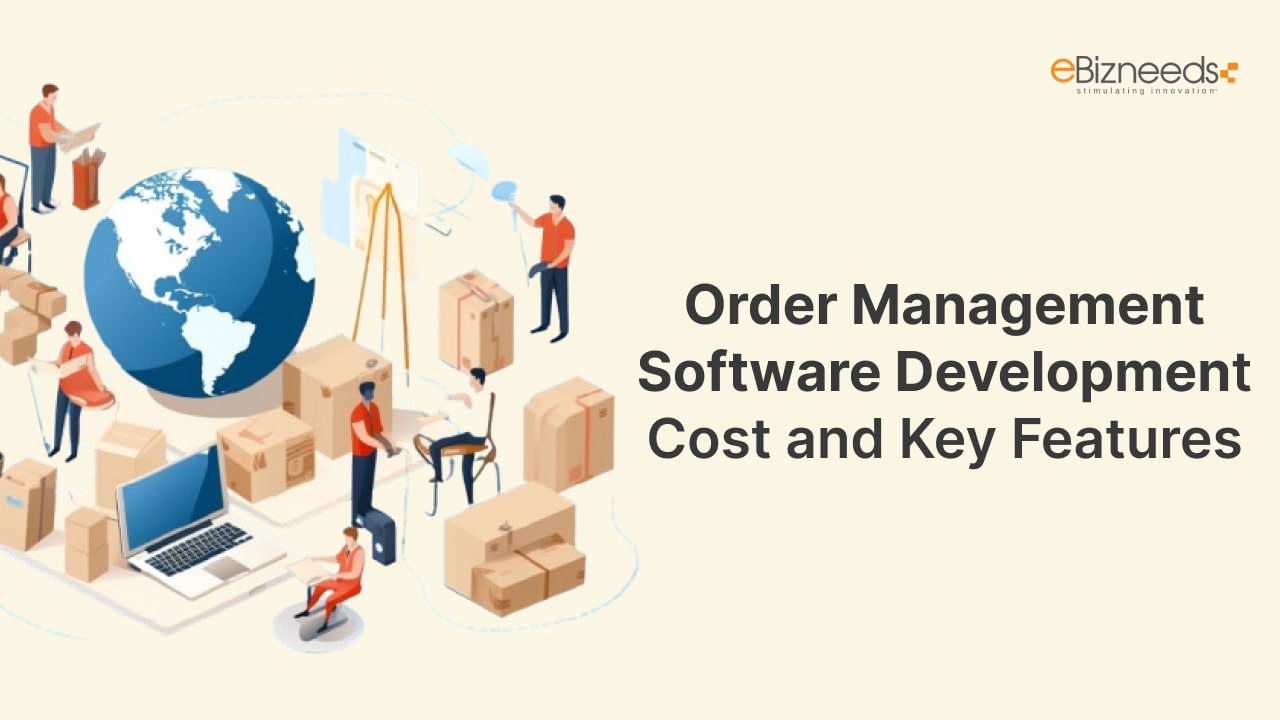Are you looking for ways to improve business efficiency and keep your customers happy? Well, building strong order management software (OMS) is key. In today’s business environment, managing orders effectively is crucial for smooth operation and customer satisfaction. However, developing an OMS can be a little expensive for you but essential for streamlining operations and creating a better customer experience. According to the updates, the OMS market was valued at 2.95 USD billion in the year 2023. The market is expected to grow at a rate of 5.48% by 2030 year. This rate shows a great business opportunity for entrepreneurs who want to enter in modern commerce.
Order management systems (OMS) solve the biggest issues by acting as a central system that connects eCommerce platforms, inventory, and shipping partners. This helps businesses make better decisions and improve management processes.
In this blog, we will cover the main factors that affect the cost of order management software development and highlight the important features that a good OMS should have. By understanding the cost and key features, businesses can make accurate decisions when investing in order management software development to improve their operations and ensure long-term success.
Are you ready to create your own OMS? Keep reading this blog to know everything you need to know before getting started.
What is Order Management Software?
Order management software is a digital tool that enables businesses to handle orders more smoothly and automatically. The OMS tool manages the entire order process very smoothly from start to finish. As it also makes sure that each activity runs efficiently. The Key features of Order Management Software Development usually include order entry, inventory tracking, order processing, and customer relationship management (CRM).
The primary objective of building a tool like OMS is to make order processing faster and more accurate. By offering real-time inventory updates, OMS helps businesses manage stock better, preventing overstocking or running out of products.
Additionally, OMS links both physical and online sales channels as it brings all orders into one system. This helps teams communicate better, reduce mistakes, and improve customer satisfaction.
Market Overview of Order Management Software
- It is estimated that the global multichannel order management market was worth $2.7 billion in revenue in the year 2022.
- The global order management software market is expected to make between 2.7 billion US dollars in revenue in the year 2022.
- The market is projected to grow faster with a compound annual growth rate (CAGR) of 9.4% that will reach over $4.2 billion by the end of the year 2027.
- The market is expected to keep growing in the coming years with an annual growth rate between 5.48% and 11.6%.
Order Management Software Across Various Industries
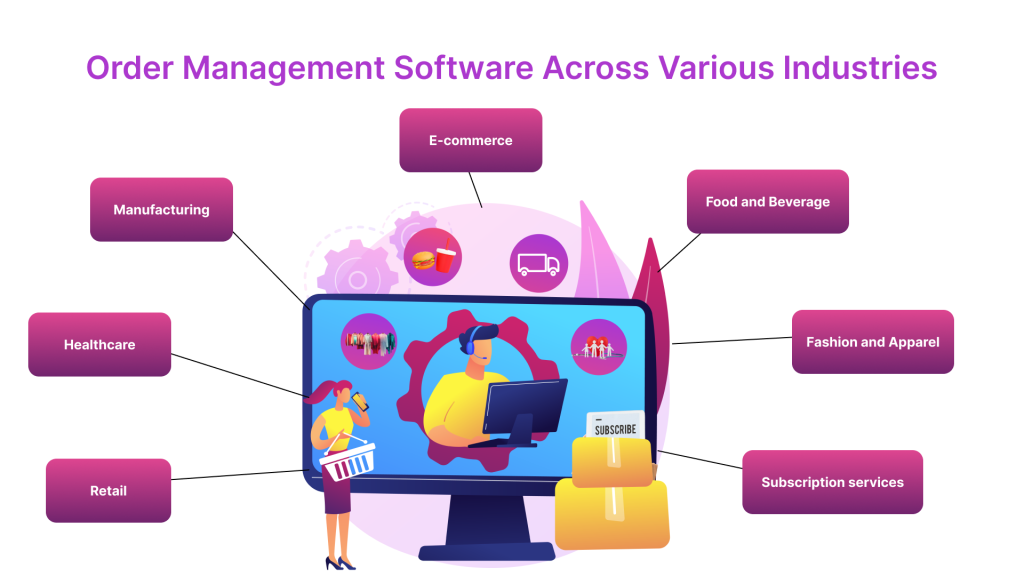


Imagine, you are running a business with thousands of orders coming in from various sources like phones, stores, and websites and you are dealing with different products and changing stock levels. It can be overwhelming to manage all these orders at the same time. That’s where order management software can help. If you want to see how this software benefits different industries then stay connected with us!
Manufacturing
In the industry, businesses get improved insight into production and order fulfillment. With manufacturing software, companies can track raw materials, manage production schedules, and ensure timely deliveries. This helps speed up production and keeps customers happy.
E-commerce
In the industry, businesses get improved insight into production and order fulfillment. With manufacturing software, companies can track raw materials, manage production schedules, and ensure timely deliveries. This helps speed up production and enhance customer experience.
Healthcare
OMS ensures that medical supplies are delivered accurately. Healthcare software development services help businesses follow strict rules, keep track of expiration dates, and make sure deliveries are safe.
Subscription Services
In the food and beverage industry, OMS manages perishable items and special delivery needs. To create a successful food ordering app, make sure it handles temperature-controlled storage, tracks expiration dates, and schedules deliveries to keep items fresh.
Retail
OMS handles orders from physical stores, online shops, and marketplaces. This retail management software helps businesses keep track of inventory at various locations and ensures that orders are picked and packed efficiently for quick fulfillment.
Food and Beverages
In the food and beverage industry, OMS manages perishable goods and special delivery needs. To build a successful food ordering app, make sure it can handle temperature-controlled storage, keep track of expiration dates, and schedule deliveries to maintain the freshest quality.
Fashion and Apparel
Order management software helps businesses handle frequent style changes, various sizes, and seasonal trends. It tracks inventory by color, size, and style to prevent running out of stock or having too much stock.
What are the Advantages of Developing Order Management Software?



Order management software can transform businesses by simplifying processes, enhancing customer satisfaction, and increasing efficiency. If you want to learn how investing in this software can help your business then check out these key reasons.
Decisions Based on Data
With OMS, businesses can gather important information about orders, customer behavior, and inventory levels. This data offers valuable insights that entrepreneurs can use to make accurate decisions. By effectively using this information, businesses can make choices that help them grow and increase their profits as well as sales.
Growth-Friendly and Flexible
We all are aware of that the business and always changing and growing. Order management software helps keep up with this growth by being flexible and scalable. It can be easily added to your current system as order management software development allows you to handle more orders, offer new products, and explore new sales channels.
Better Order Accuracy and Faster Processing
Order management software automates tasks like gathering customer details, checking product availability, and creating pick lists. This helps reduce mistakes, speeds up the order process, and leading timely delivery of ordered products.
Improved Multichannel Experience
Customers expect a smooth shopping experience whether they buy online, in-store, or through a marketplace. Order management software helps businesses handle orders from all these places in one system. It ensures a seamless experience by allowing customers to start their purchase online and pick it up in-store or start in-store and finish online with all order details managed in one place.
Instant Inventory Updates
Order management software gives you a unified view of your inventory across all sales channels like physical stores, online shops, and marketplaces. This helps prevent overselling that’s a common problem with manual inventory management.
Essential Steps to Create Order Management Software
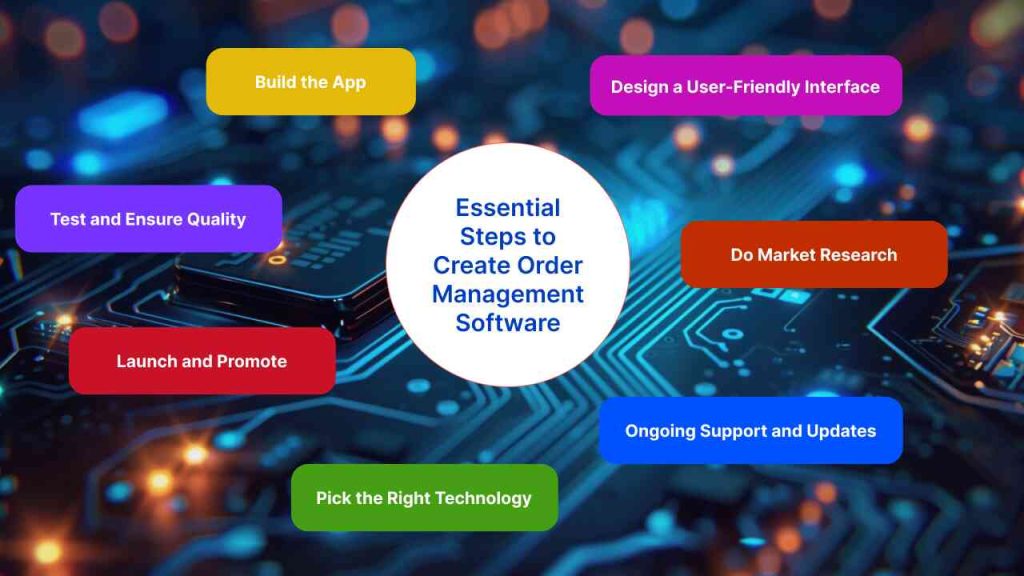


It’s an important section of this blog where you will get to know the key steps of building order management software. Creating an effective OMS involves several steps. If you follow these steps you will be on your way to achieving your business goals. Let’s discuss the process of developing order management software with the following steps.
Do Market Research
If you decide to develop your own OMS then before starting the procedure do market research. To make your app successful you need to understand your target audience whether they are wholesalers or retailers. It’s also essential to look at existing competitors to learn their strategies and find ways to make your app unique.
Pick the Right Technology
Now it’s time to choose the right technology for your order management software development. A reliable software Development Company may help you find the core technology and let you know a lot about programming languages, frameworks, and databases. While choosing the right tech stack try then you must consider the top factors like scalability, and security.
Design a User-Friendly Interface
Everyone wants to make their app successful. A good user experience and the user interface is key. Focus on creating a simple and easy-to-use design. Make sure the app allows users to move around smoothly and quickly find the information they need. This means you should carefully plan how users will interact with the app, use good design principles, and organize information clearly.
Build the App
In this step, the supply chain management software development company turns your app ideas into reality by coding its main functions. This includes managing inventory, capturing orders, automating fulfillment, and connecting with other business systems like CRM or accounting software. Additionally, when developing sales or purchase order management software then adding all the important and unique features can greatly improve its chances of success.
Test and Ensure Quality
Once you’ve built the main features of your purchase or sales order management software, now it’s important to test it thoroughly to make sure it’s working correctly and is ready for launch. Testing is important to make your software bug-free and remove errors. Testing in various scenarios helps find and fix any issues before you go live. Getting feedback from potential users during user acceptance testing is also crucial. This feedback helps you make necessary improvements. By following this process, you can ensure your app is ready before it’s released.
Launch and Promote
Now your software is ready to go! So it’s time to launch it for different devices like IOS and Android. First, deploy your order management software by releasing it to a small group of users in a soft launch before going live to your audience. Next, you need to make a well-working marketing plan to reach your target audience. You can use various social media platforms for content marketing and run email campaigns to generate excitement among your users. Always keep focusing on showcasing the unique features of your OMS and offer trials to draw in users.
Ongoing Support and Updates
After launching your order management software, it’s essential to keep it updated and well-maintained to keep the users interested. You should offer great customer service to help users with any issues and gather feedback for making improvements in the future. Regularly updating your software makes it bug-free, improves security, and adds unique features. This helps businesses stay in tune with their user’s needs and keep them satisfied.
Key Features of an Order Management Software
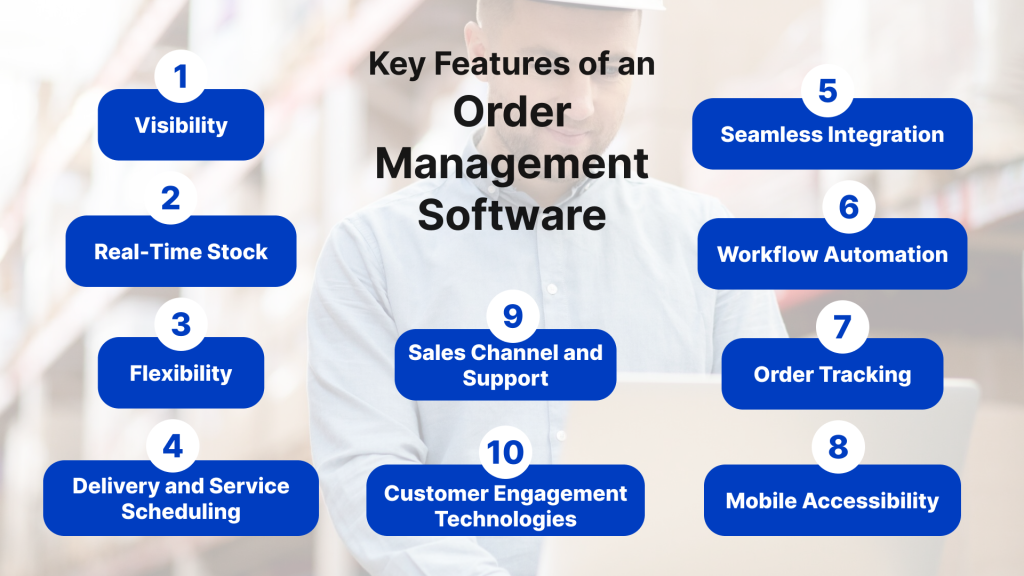


Good order management software development is essential for running a business smoothly and managing the inventory. Want to make your OMS more efficient? Here we are excited to share the key features that should be added to your order management software to ensure a flawless experience.
Visibility
The software should let businesses see the entire order management process. This means they can track orders, monitor inventory levels, and analyze performance metrics using real-time data.
Real-time Stock
It should help companies stay ahead by managing stock levels and placement and eliminating uncertainty about inventory. This could be a cloud-based system that gives real-time updates on inventory levels, locations, and logistics.
Flexibility
A flexible web-based order management system should have customizable workflows that can be adjusted to meet the unique needs of a business as it evolves. This ensures the system can grow and become simpler over time.
Delivery and Service Scheduling
It should help businesses plan deliveries and services based on customer needs, availability, and delivery options. This feature ensures that deliveries are timely and efficient.
Seamless Integration
This feature ensures that your current ERM, warehouse, and accounting software so that all your data flows smoothly in one place.
Workflow Automation
Inventory and order management software automates repetitive tasks such as confirming orders, sending shipping notifications, and alerting you when stock is low.
Order Tracking
Develop order management software that keeps track of shipments while providing detailed information on their location and precise delivery times.
Mobile Accessibility
Your order management should be able to handle orders and provide important details easily on a mobile-friendly interface.
Sales Channel and Support
It should support multiple sales channels such as online stores, mobile apps, and physical stores. It should also provide sales staff with the information and tools they need to do their job effectively.
Customer Engagement Technologies
It should include personalized marketing, customer self-service options, and support across multiple channels to better engage with customers.
Important Order Management KPIs & Metrics to Monitor
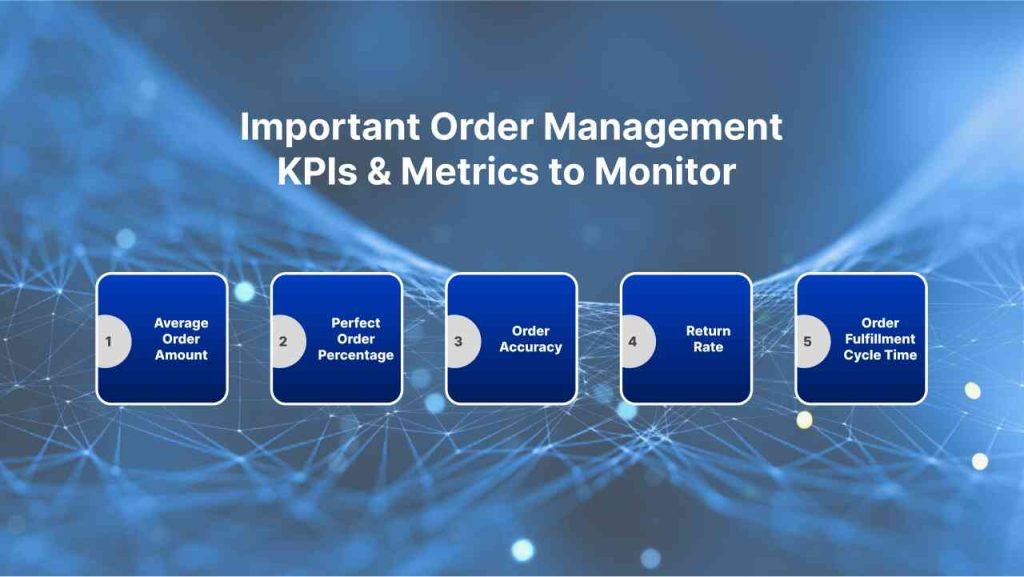


Order management software development is very essential for a great customer experience. Thus, OMS covers everything from when a customer orders the item to when they receive their order. By monitoring key performance indicators (KPIs) and metrics, businesses can spot areas that need improvement and ensure they are handled smoothly and efficiently. We will cover the top 5 KPIs that should be considered:-
Average Order Amount
This KPI shows the average value of an order. A higher average order value means the customers loves to buy more products in a single order. This suggests that customers are interested in a wider range of products. It could also indicate that customers trust the brand or are leaning towards more expensive or luxury items.
Perfect Order Percentage
The main goal of order management software development is to ensure the products have been delivered on time, undamaged, and complete. A higher customer satisfaction and a high rate of flawless orders show that everything is running smoothly. This reflects efficient order fulfillment and strong teamwork across departments. A high perfect order rate helps businesses gain customer loyalty and encourage customers to purchase again.
Order Accuracy
When orders are fulfilled correctly, it means fewer returns, lower costs for handling returns, and happier customers who get their orders successfully. To keep accuracy high, quality checks during picking and training for staff are important. Using warehouse management software can improve order-picking accuracy by making the process more efficient.
Return Rate
A lot of customers use the return option to send back the products they ordered due to quality or size issues, inaccurate product details on the website, and so on. Some returns can’t be avoided due to reasons like changing your mind or needing a different size. However, if orders are returned in bulk it can create big issues.
Order Fulfillment Cycle Time
Faster fulfillment leads to higher customer satisfaction. Efficient order processing gives businesses an advantage as customers expect speedy service. To achieve this, streamlining picking, packing, and shipping by using order management software development can make the process faster and more efficient.



Technology Stack for Order Management Software Development
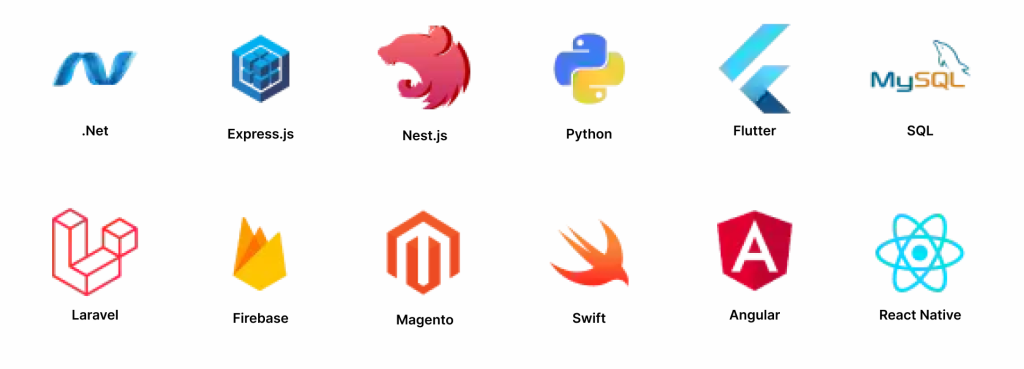


To build order management software, you need a flexible and strong tech stack to ensure it works well and performs smoothly. The table below shows the key tech stack that will help you develop a successful order or inventory management system.
Backend (Programming languages like Python, Java, and Go)
It outlines key features such as handling orders, managing inventory, and connecting with other systems.
Database (MySQL and PostgreSQL are types of SQL databases)
Stores keep track of order data, customer info, and product details.
API gateway (API Gateway and Flask-RESTful)
Manages communication between backend and frontend services
Messaging Queue (RabbitMQ, Kafka)
Enables non-simultaneous communication between microservices for handling orders.
Cloud Platform (AWS, Google Cloud, and Microsoft Azure)
Offers flexible infrastructure for both deployment and management.
Frontend (JavaScript frameworks like React and Angular)
Provides adaptable infrastructure for both deployment and management.
Cache (Redis, Memcached)
Enhances efficiency by saving data that’s accessed often.
Top 5 Order Management Software
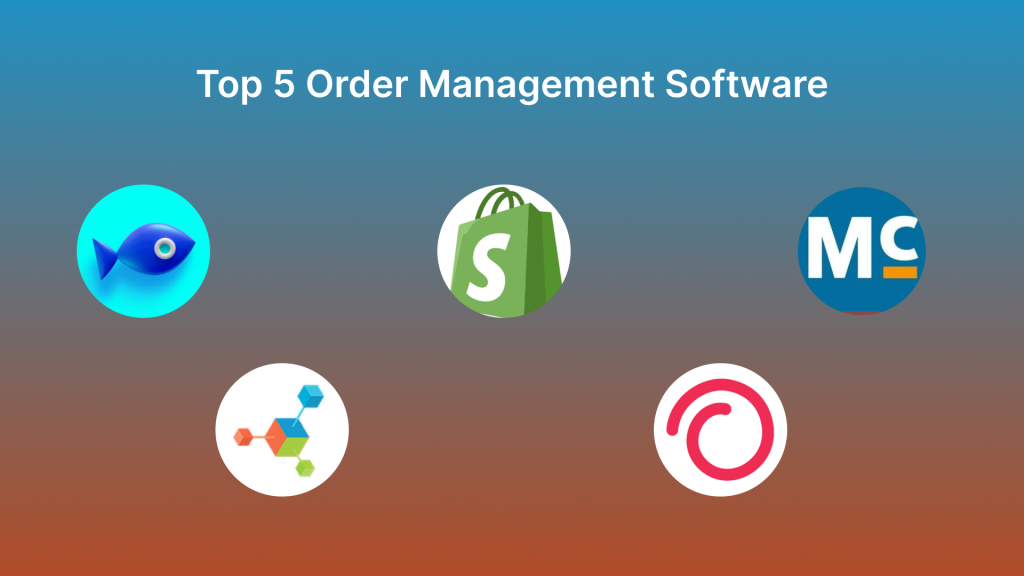


Here we are going to discuss the top 5 order management software platforms that are leading worldwide. Let’s explore these platforms!
Fishbowl
Fishbowl is considered as the best Order Management platform. This MRP (material requirements planning) system is made for manufacturing. It’s great at scheduling products, keeping inventory under control, and managing work orders effectively.
Orderhive
It’s a complete order management system designed for e-commerce businesses. The platform helps manage inventory across various sales channels, automates order fulfillment, and offers useful insights to improve business operations and streamlines processes.
Shopify
Shopify’s order management software is a complete e-commerce platform that helps you build online stores, handle products, and process payments all in one place.
Ordermaek
Ordermaek is the best B2B (Business-to-business) order management software that connects restaurants with their suppliers. It automates the ordering process, reduces mistakes, and enhances communication between both sides.
Mckesson
As a top player in healthcare supply chain management, the platform provides order management solutions designed specifically for hospitals and medical providers. It makes the ordering process smoother as it also helps businesses keep essential supplies readily available.
Cost Breakdown for Developing Order Management Software
Are you aware of the investment required to develop top-notch order management software? Estimating the cost of order management software development is more intricate than it may seem. Factors such as the app’s design, type, features, and development platform significantly impact the cost of creating multichannel order management software.
Additionally, if your software has specific or unique needs, it will add to its complexity. Consequently, there will be considerable variations in the cost of order management software development as detailed in the table below.
| Order Management Software Development | Time Frame | Estimated Cost |
| Simple Order Management Software Development | 3 to 6 Months | $8000 – $13000 |
| Medium Complex Order Management Software Development | 6 to 9 Months | $13000 – $21000 |
| High Complex Order Management Software Development | More Than a Year | $25000+ |
Conclusion
If you are planning to invest in order management software development then can lead to great returns. It helps businesses improve customer satisfaction, boost revenue, and streamline procedures. For entrepreneurs, there’s a great chance to benefit from the growing need for tech-driven and efficient solutions. Building order management software could transform your business. So why wait? Talk to a custom software development company to transform your business. You might consider eBizneeds, known for its expertise, user-friendly features, innovative solutions, reliable support, and proven success in delivering top-quality order management software.



FAQs
The cost of making order management software depends on a number of factors such as its complexity, features, and experience of developers. Generally, it can cost between $8,000 and $25,000. Adding extra features for customers or connecting with other systems can make it more expensive.
The four main steps in the order management are:-
1. Accepts the order
2. Picking and packing the product
3. Shipping
4. Track the order until the customer gets it
In your OMS, you should include the security process such as following regulations, data encryption, authenticating users, performing regular security checks, and controlling access based on roles
The time it takes to develop an Order Management System (OMS) varies based on how complex and extensive the software is. Typically, creating order management software can take between 3 to 11 months. More complex features and customizations may make the development time longer.
An OMS can make your business run better by:-
1. Improving inventory control
2. Cutting down on mistakes
3. Simplifying tasks
4. Boosting customer satisfaction
5. Offering helpful insights
An OMS can make your business run better by:-
1. Cutting down on mistakes
2. Improving inventory control
3. Simplifying tasks
4. Boosting customer satisfaction
5. Offering helpful insights



Naveen Khanna is the CEO of eBizneeds, a company renowned for its bespoke web and mobile app development. By delivering high-end modern solutions all over the globe, Naveen takes pleasure in sharing his rich experiences and views on emerging technological trends. He has worked in many domains, from education, entertainment, banking, manufacturing, healthcare, and real estate, sharing rich experience in delivering innovative solutions.
